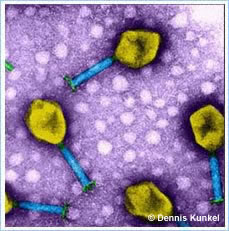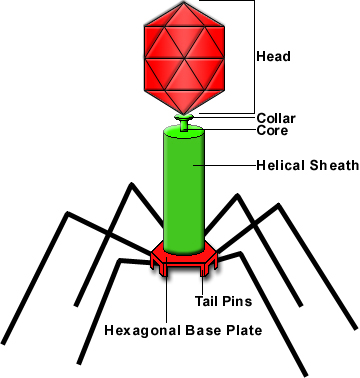
|
Jaime Moore and Tiffany Fu
|
| AbstractBacteriophage are viruses that infect bacterial cells. As with all viruses, phage are nonliving agents and thus require the use of the hostís metabolic processes to replicate itself. In this experiment, the phage of interest are those that infect and lyse E. coli B host cells. When phage are released from the ruptured host, distinct zones of clearing (plaques) form. The original E. coli host cells for this experiment came from a sample of raw sewage, obtained from a local water treatment plant. In order to obtain the bacteriophage, a general four-phase procedure of enrichment, isolation, dilution and seeding was followed. The presence of distinct plaques indicated that lytic bacteriophage had been successfully amplified, separated and grown. Ultimately, two different phage organisms were isolated, as was indicated by the existence of two disparate sizes of plaques. The approximate phage titer was calculated to be 1.6666667 x 10^7 large phage/ mL for the large plaque forming phage and 5.5666667 x 10^7 small phage/mL for the tiny plaque forming phage. The two types of phage were not successfully separated, but the isolated phages are most likely T4, T1-T7, f174, Ms2 or Qb phage. |  |
| Introduction
Enrichment culture is a technique used to isolate organisms by incubation under highly specific conditions that both optimize growth and ensure that the culture is the desired organism. Using previously acquired knowledge about the organismís characteristics, environmental factors can be controlled to limit the possibility that the culture contains other organisms and to allow the desired organism to proliferate rapidly. Such factors may include optimal temperature, salinity, other nutrients, and aerobic or anaerobic conditions. Furthermore, tests, selective media, and other indicators can be used to identify specific organisms for isolation. Bacteriophage are considered infectious ďagentsĒ rather than cells because they cannot replicate themselves on their own and are obligate parasites that require a host. They consist of nucleic acid contained by a protein coat, called a capsid. Isometric viruses have a geometric symmetrical shape, and helical viruses have a long rod shape that consists of a spiral nucleic acid and protein sheath. Viruses that commonly infect E. coli include the T-even bacteriophage, which have the complex structure, consisting of an icosahedra capsid head, a sheath, and attaching tail fibers. When bacterial cells are infected, phages replicate inside and lyse the cell, causing clearings in bacteria lawns called plaques. Aside from electron microscopy, the viruses cannot be seen as bacterial cultures can. However, plaque assays may be performed to determine the presence and number of viriods in a sample. Each plaque represents one virion that initially infected a single cell, and if the quantity of a sample is known, the concentration of viruses can be determined. The methods and protocol developed was based off of Microbiological
Applications: A Laboratory Manual in General Microbioloy, however adjustments
were made in order to be time efficient in producing several successive
isolations. Because this is a published, reviewed source for developing
a procedure, successful results were expected. In terms of enrichment,
the selective environment was created by selecting a specific host (E.
coli B), and accomodating the host's growth requirements with specific
conditions such as nutrient media and optimal temperature. The use of a
specific host eliminates the possibility of obtaining phage that infect
organisms other than E. coli B.
|
| Hypothesis:
If the phage is present in a sample of raw sewage, it should be possible
to isolate it from its host, E. coli, through centrifugation and filtration.
Filtrate should contain phage that can be inoculated into cultures of E.
coli, incubated, and result in infection. Infection is detected by the
presence of plaques in lawns of E. coli. The process should be reproducible,
by inoculating fresh E. coli with a plaque that resulted from the prior
incubation.
|
| Links
|
 |
| References
1 - Benson, Harold J. Microbiological Applications: A Laboratory
Manual in General Microbiology. Wm.c.Brown Publishers, Pasadena City
College. (c)1990 p.105-107
|